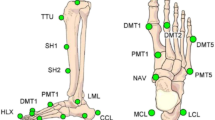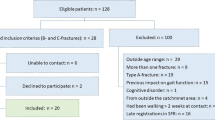Abstract
Purpose
Axial burst fractures of the distal tibia are challenging to treat and often lead to restricted function of the lower limb. The purpose of this study was to investigate the clinical outcome and changes in gait pattern in such patients.
Methods
Thirty-five patients in a level 1 trauma centre were followed up clinically and by gait analysis. The American Orthopaedic Foot and Ankle Society (AOFAS), visual analogue scale (VAS) foot and ankle scale and Phillips scores were applied. Dynamic pedography (emed-M; Novel, Germany) with analyses of load, pressure and force-time integral were undertaken to investigate possible changes in gait pattern.
Results
Mean follow-up was 50 (19–100) months. Mean AOFAS, VAS foot and ankle and Phillips scores were 65, 63 and 55 points, respectively. There were clear correlations between fracture severity in the Arbeitsgemeinschaft für Osteosynthesefragen (AO) classification and functional outcome in AOFAS (−0.63; p < 0.01), VAS foot and ankle scale (−0.56; p < 0.01) and Phillips (−0.64; p < 0.01) scores. There was a high correlation of 0.74 (p < 0.01) between the severity of the injury in the AO-classification and onset of post-traumatic arthrosis. Dynamic pedography revealed lesser load bearing for the total foot, medial foot, heel, first metatarsal and medial forefoot for the affected limb, and increased load bearing was seen in the lateral midfoot region.
Conclusions
Fractures of the tibial pilon lead to restricted function of the lower limb. Clinical outcome correlates with fracture severity in the AO classification, the onset of post-traumatic arthrosis and changes in gait patterns.






Similar content being viewed by others
References
Bacon S, Smith WR, Morgan SJ, Hasenboehler E, Philips G, Williams A, Ziran BH, Stahel PF (2008) A retrospective analysis of comminuted intra-articular fractures of the tibial plafond: Open reduction and internal fixation versus external Ilizarov fixation. Injury 39(2):196–202. doi:10.1016/j.injury.2007.09.003
Conroy J, Agarwal M, Giannoudis PV, Matthews SJ (2003) Early internal fixation and soft tissue cover of severe open tibial pilon fractures. Int Orthop 27(6):343–347. doi:10.1007/s00264-003-0486-1
Blauth M, Bastian L, Krettek C, Knop C, Evans S (2001) Surgical options for the treatment of severe tibial pilon fractures: a study of three techniques. J Orthop Trauma 15(3):153–160
Patterson MJ, Cole JD (1999) Two-staged delayed open reduction and internal fixation of severe pilon fractures. J Orthop Trauma 13(2):85–91
Sirkin M, Sanders R, DiPasquale T, Herscovici D Jr (2004) A staged protocol for soft tissue management in the treatment of complex pilon fractures. J Orthop Trauma 18(8 Suppl):S32–S38
Tong D, Ji F, Zhang H, Ding W, Wang Y, Cheng P, Liu H, Cai X (2012) Two-stage procedure protocol for minimally invasive plate osteosynthesis technique in the treatment of the complex pilon fracture. Int Orthop 36(4):833–837. doi:10.1007/s00264-011-1434-0
Pollak AN, McCarthy ML, Bess RS, Agel J, Swiontkowski MF (2003) Outcomes after treatment of high-energy tibial plafond fractures. J Bone Joint Surg Am 85-A(10):1893–1900
Topliss CJ, Jackson M, Atkins RM (2005) Anatomy of pilon fractures of the distal tibia. J Bone Joint Surg Br 87(5):692–697. doi:10.1302/0301-620X.87B5.15982
Marsh JL, Weigel DP, Dirschl DR (2003) Tibial plafond fractures. How do these ankles function over time? J Bone Joint Surg Am 85-A(2):287–295
Muller ME NS, Koch P, Schatzker J (1990) The comprehensive classification of fractures of long bones
Richter MZS, Geerling J, Frink M, Knobloch K, Krettek C (2006) A new foot and ankle outcome score: Questionnaire based, subjective, Visual-Analogue-Scale, validated and computerized. Foot Ankle Surg 12:191–199
Kitaoka HB, Alexander IJ, Adelaar RS, Nunley JA, Myerson MS, Sanders M (1994) Clinical rating systems for the ankle-hindfoot, midfoot, hallux, and lesser toes. Foot Ankle Int 15(7):349–353
Phillips WA, Schwartz HS, Keller CS, Woodward HR, Rudd WS, Spiegel PG, Laros GS (1985) A prospective, randomized study of the management of severe ankle fractures. J Bone Joint Surg Am 67(1):67–78
Kellgren JH, Lawrence JS (1957) Radiological assessment of osteo-arthrosis. Ann Rheum Dis 16(4):494–502
Rüedi TP, Allgöwer M (1969) Fractures of the lower end of the tibia into the ankle joint. Injury 2:92–99
Joveniaux P, Ohl X, Harisboure A, Berrichi A, Labatut L, Simon P, Mainard D, Vix N, Dehoux E (2010) Distal tibia fractures: management and complications of 101 cases. Int Orthop 34(4):583–588. doi:10.1007/s00264-009-0832-z
Lau TW, Leung F, Chan CF, Chow SP (2008) Wound complication of minimally invasive plate osteosynthesis in distal tibia fractures. Int Orthop 32(5):697–703. doi:10.1007/s00264-007-0384-z
Chen SH, Wu PH, Lee YS (2007) Long-term results of pilon fractures. Arch Orthop Trauma Surg 127(1):55–60. doi:10.1007/s00402-006-0225-3
Ketz J, Sanders R (2012) Staged posterior tibial plating for the treatment of Orthopaedic Trauma Association 43C2 and 43C3 tibial pilon fractures. J Orthop Trauma 26(6):341–347. doi:10.1097/BOT.0b013e318225881a
Kiene J, Herzog J, Jurgens C, Paech A (2012) Multifragmentary tibial pilon fractures: midterm results after osteosynthesis with external fixation and multiple lag screws. Open Orthop J 6:419–423. doi:10.2174/1874325001206010419
Leung F, Kwok HY, Pun TS, Chow SP (2004) Limited open reduction and Ilizarov external fixation in the treatment of distal tibial fractures. Injury 35(3):278–283
Teeny SM, Wiss DA (1993) Open reduction and internal fixation of tibial plafond fractures. Variables contributing to poor results and complications. Clin Orthop Relat Res 292:108–117
Egol KA, Wolinsky P, Koval KJ (2000) Open reduction and internal fixation of tibial pilon fractures. Foot Ankle Clin 5(4):873–885
Horisberger M, Hintermann B, Valderrabano V (2009) Alterations of plantar pressure distribution in posttraumatic end-stage ankle osteoarthritis. Clin Biomech (Bristol, Avon) 24(3):303–307. doi:10.1016/j.clinbiomech.2008.12.005
Hirschmuller A, Konstantinidis L, Baur H, Muller S, Mehlhorn A, Kontermann J, Grosse U, Sudkamp NP, Helwig P (2011) Do changes in dynamic plantar pressure distribution, strength capacity and postural control after intra-articular calcaneal fracture correlate with clinical and radiological outcome? Injury 42(10):1135–1143. doi:10.1016/j.injury.2010.09.040
Acknowledgements
The authors are grateful to Dr. Sabine Karl of the Institute of Mathematics at the University of Wuerzburg for her help and advice on statistics.
Conflict of interest statement
The study was conducted in compliance with the current laws applying in Germany. None of the authors has any conflicts of interest.
Author information
Authors and Affiliations
Corresponding author
Rights and permissions
About this article
Cite this article
Jansen, H., Fenwick, A., Doht, S. et al. Clinical outcome and changes in gait pattern after pilon fractures. International Orthopaedics (SICOT) 37, 51–58 (2013). https://doi.org/10.1007/s00264-012-1716-1
Received:
Accepted:
Published:
Issue Date:
DOI: https://doi.org/10.1007/s00264-012-1716-1




